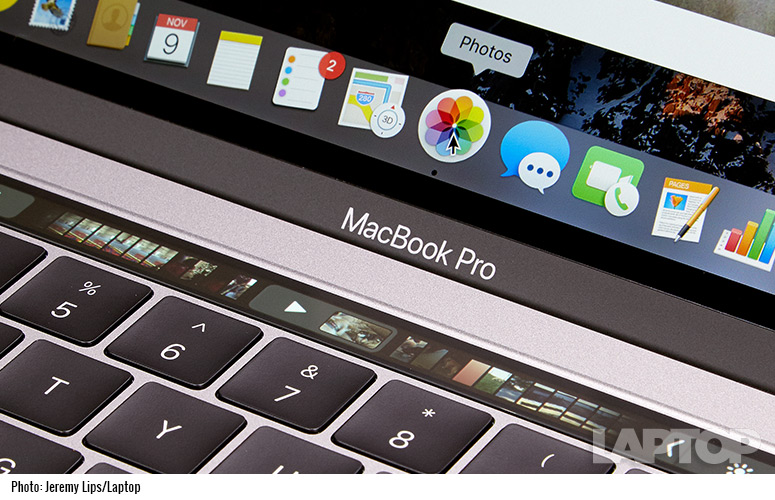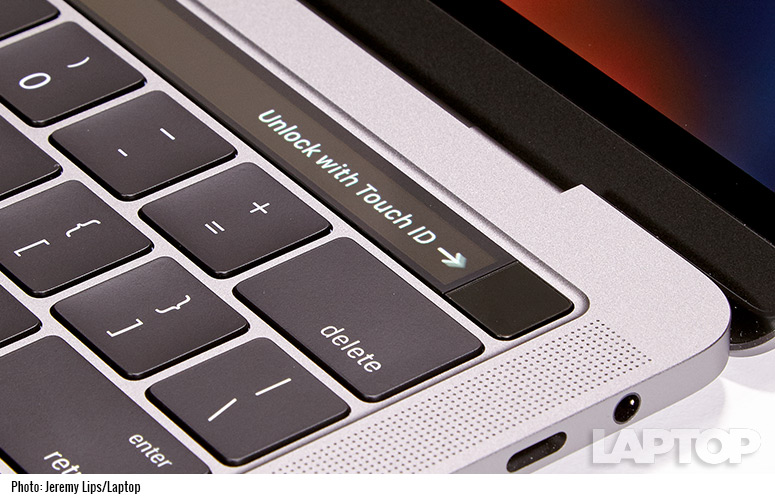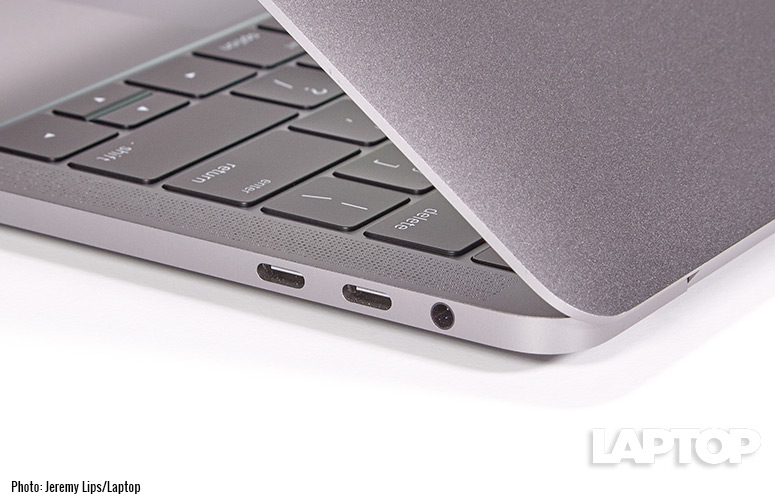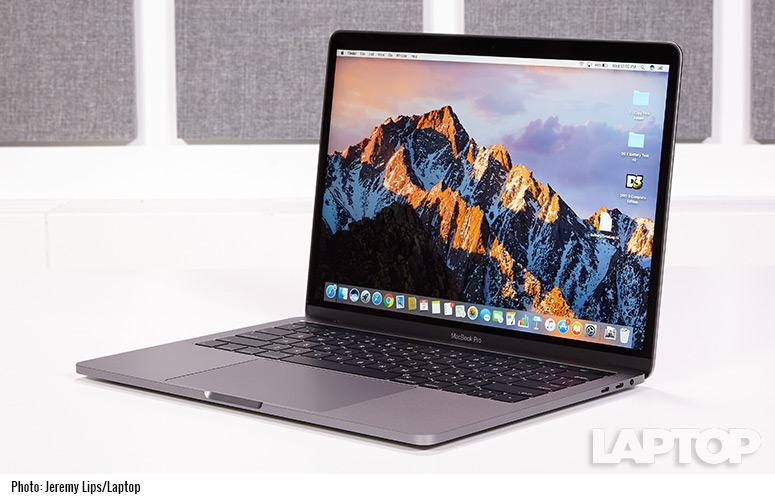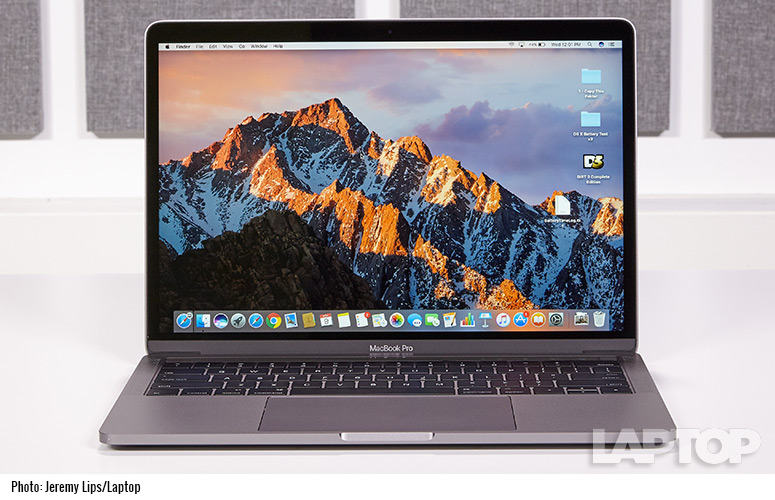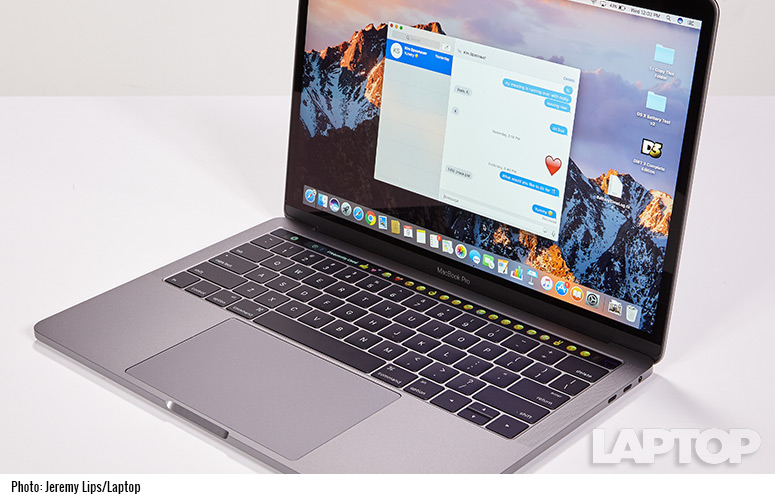Laptop Mag Verdict
The 13-inch MacBook Pro with Touch Bar offers a fresh way to interact with apps, as well as more ports and speed than the base model, but the experience doesn't yet justify the premium.
Pros
- +
Innovative Touch Bar
- +
Touch ID speeds up logins
- +
Bright and colorful display
- +
Solid, compact design
- +
Great speakers
Cons
- -
Expensive
- -
Lacks SD card slot and full-size USB port
- -
Hour less battery life than non-Touch Bar model
Why you can trust Laptop Mag
Part mesmerizing, part helpful and part distracting. I have mixed emotions about the new Touch Bar on the 13-inch MacBook Pro, which Apple calls revolutionary. A narrow strip above the keyboard, this interactive display lets you do everything from toggling between open-browser tabs and editing photos with a tap to inserting contextually relevant emojis. Apple is letting third-party apps in on the act, too. But is this notebook worth $1,799, or $300 more than the MacBook Pro without the Touch Bar?
The good news is that Apple also gives you two extra ports and a faster processor and graphics for that premium, but you'll have to sacrifice some battery life for its versatility. And the Touch Bar simply doesn't add that much value -- at least not yet.
Touch Bar: Clever, But Not Complete
It's like a touch screen, but also not. Apple's Touch Bar is an innovative multi-touch display that replaces the traditional function row, with a resolution of 2170 pixels across by only 60 pixels high. Apple deserves credit for making the most of this limited real estate, but right now it feels more evolutionary than revolutionary.
By default, the Touch Bar shows traditional buttons that you're used to, including screen brightness, volume controls and keyboard backlight controls, as well as shortcuts to Mission Control. There's also a colorful Siri button on the right. It gets a lot more interesting once you start diving into various apps.
MORE: Best Touch Bar Apps for Your New MacBook Pro
For instance, in the Photos app you can skim your finger along the Touch Bar to flip through your images, or press dedicated buttons to rotate a photo or favorite it. Once you press the Edit button, a whole different set of options appears, including Crop, Filters, Adjust and Retouch. I had fun flipping through various filters quickly just by gliding my finger across the Touch Bar and previewing the result, something I couldn't do with the touchpad.
Sign up to receive The Snapshot, a free special dispatch from Laptop Mag, in your inbox.
On the other hand, my first instinct upon touching the Crop button on the Touch Bar was to then reach up to the screen to crop my photo. No can do.
I did appreciate seeing various emojis pop up as I typed in the Messages app, such as a somewhat worried face when I informed my wife I was stuck in traffic. Or if I typed "What's for dinner?" it was cool to see the knife and fork emoji suggested. Also cool: being able to tap a Phone button in the Maps app to dial a business I looked up; the call went to my iPhone.
MORE: Best Apple Laptops
I had mixed results with Safari. The Touch Bar shows thumbnail previews of open tabs, but they're so small it's hard to make them out. It also didn't help that the CNN tab had the picture of a Liberty Mutual ad. Clicking on the address bar brought up logos of my favorite sites on the Touch Bar, which I found more useful.
Several other Apple apps take advantage of the Touch Bar, including Mail, Pages, Keynote, GarargeBand and Final Cut. Power users will like that several apps also let you customize which buttons go where on the Touch Bar.
For Touch Bar to take off, lots of third-party apps will need to support this new way to interact, and Apple is off to a decent start. Photoshop, Microsoft Office, Pixelmator, DJ Pro and Sketch are on board and more are on the way. But even then, the bar is no replacement for a touch display.
Touch ID: Quicker Logins, Easier Apple Pay
Simple and straightforward, the Touch ID button on the very right edge of the Touch Bar lets you log in with just a simple tap. Once I set up my fingerprint, I was able to sign on instantaneously using the capacitive sensor.
You can also use Touch ID for making purchases on sites that offer Apple Play, such as Jet, B&H, Overstock, Staples, Panera, Seamless, Fandango and StubHub.
Design: Sleek and Solid
While the glowing, dynamic Touch Bar on the 13-inch MacBook Pro makes this laptop feel a bit like it's from the future, the rest of the machine is identical to the entry-level model. That's not a bad thing, as it's more compact and lighter than its predecessor, and it's available in a more handsome Space Gray color. The Silver is too familiar-looking.
Measuring 11.97 x 8.36 x 0.59 inches and weighing 3.02 pounds, this MacBook Pro is just as light as the (still kicking) MacBook Air. However, other Windows ultraportables and convertibles are lighter and thinner, such as the Dell XPS 13 (2.7 pounds, 0.33 to 0.6 inches thick) and HP Spectre x360 (2.8 pounds, 0.54 inches). The new Surface Book with Performance Base is heavier and thicker (3.68 pounds, 0.59-0.90 inches).
Ports: More, But Not the Ones I Want
Easily the most controversial thing about the MacBook Pro is Apple's choice of ports. You get four Thunderbolt 3 ports, two on each side, along with a headphone jack. The Thunderbolt 3 ports certainly are versatile, as they carry power and data over a USB-C connector, and you can connect up to two 4K monitors.
But not having an SD Card slot or full-size USB port feels like ripping us into the future too soon. I know firsthand because I attended a press event with our staff photographer, and when it came time to transfer the video from his DSLR to my laptop we needed to borrow someone else's USB-C memory card reader.
Want to connect your iPhone to the MacBook Pro? You'll need a separate dongle. At least Apple has decided to lower prices on USB-C accessories through the end of the year. You can pick up a USB-C to USB adapter for $9, a USB-C to Lightning Cable for $19 and a USB-C Digital AV Multiport Adapter (which has a full-size USB port and HDMI connector) for $49. Still, you'll have to carry around and try not to lose these extra accessories.
Display and Audio: Sheer Awesomeness
The 13-inch Retina Display on the MacBook Pro is practically perfect. It's bright, rich and sharp, making it a great canvas for watching videos, editing photos and just doing work. I could make out every crease in the leather chair Bruce Wayne sat in on the 2560 x 1600-pixel panel as he tried to persuade Flash to join the Justice League. And I saw an explosion of color when I streamed a 4K clip of flowers, including bright yellow tulips, yellow and orange poppies and purple campanula.
The screen impressed on our lab tests, too, notching 119 percent of the sRGB color gamut. That trumps the XPS 13, the Spectre x360 and the Lenovo Yoga 910, and edges out the latest Surface Book. However, this display's color accuracy score of 1.25 (where 0 is perfect) wasn't quite as good. All of its closest competitors posted under 1.
The 13-inch Pro's panel is brighter than leading Windows machines, as it registered 452 nits of brightness. That outshines the Surface Book (376), and the Dell, HP and Lenovo were all below 320 nits.
MORE: The Best Laptops for Every Need
The improved stereo speakers on the 13-inch MacBook Pro pack a punch, offering twice the power of the previous model. Every snap sounded distinct on "Closer" by The Chainsmokers, and the driving guitars on Weezer's "My Name Is Jonas" were loud and punchy without drowning out the slacker screams coming from Rivers Cuomo.
Keyboard and Touchpad: Give Butterfly a Chance
At first, the flat keyboard on the MacBook Pro can be jarring. After all, if offers just 0.5mm of travel, when 1.5mm is supposed to be ideal. But I had no problem hitting my typical 65 to 70 words per minute, as Apple has improved the tactile feedback on its second-generation butterfly mechanism. While not cushy, the keys definitely feel more responsive.
With the 3D Touch trackpad, there's just no more to love. The 5.3 x 3.2-inch area is 46 percent larger than before, giving you more room for navigating the desktop and all sorts of gestures, including three-finger swipe up for Mission Control and pinching in with your fingers to see your Mac apps.
Performance: A Step Up, But Not the Fastest
Apple includes a faster 6th-generation Core i5 processor on this laptop than the entry-level model, bumping up the clock speed from 2 GHz to 2.9GHz. You get the same 8GB of RAM and 256GB of flash storage. The result is a laptop that's swift but not as powerful as some premium Windows ultraportables with Intel's newer chips.
On Geekbench 4, which measures overall performance, the 13-inch MacBook Pro posted 7,587. That beats the entry-level MacBook Pro (7,053) and is neck and neck with Microsoft's Surface Book with its 6th-generation Core i5 CPU. This MacBook also trumps the XPS 13 with 7th-gen Core i5 (7,287). However, the HP Spectre x360 and the Lenovo Yoga 910 with 7th-gen Core i7 muscle both scored above 8,000 on this test.
Wondering how quickly the 13-inch MacBook Pro can crunch numbers? It took the system 4 minutes and 15 seconds to match 20,000 names and addresses. That's good, but the Surface Book, the HP and the Lenovo all finished the same task in under 4 minutes.
MORE: The Best Laptops for Business and Productivity
The MacBook Pro's SSD is the champ in this group, as it turned in a transfer rate of 636.16 megabytes per second. That's even faster than the storage we tested in the entry-level 13-inch MacBook Pro (508.9 MBps), and it beats the Surface Book (363.5 MBps)
Graphics
The Iris 550 graphics in this MacBook Pro are more powerful than the 540 card in the entry-level model, but it doesn't make a dramatic difference. On the OpenGL portion of the Cinebench benchmark, which measures graphics performance, this MacBook notched 36.4 frames per second.
This number is slightly better than the 35.69 fps by the entry-level MacBook Pro but trails both the Dell XPS 13 (42.62 fps) and the HP Spectre x360 (43.80 fps). The Surface Book with Performance Base blew away this Mac with 78.05 fps, thanks to its Nvidia GPU, but it also costs $2,399.
We also ran the Geekbench 4 Compute test, which measures graphics performance by evaluating image processing, computer vision and number crunching. Here the MacBook Pro performed better, hitting 30,628. That beats the Dell XPS 13, HP Spectre and Yoga 910, all of which scored under 20,000. However, the Surface Book with Performance Based doubled up the Apple with 63,900. The non-Touch Bar MacBook Pro also beat the Windows competition at 28,444.
Finally, we tested the Touch Bar MacBook Pro on the Dirt 3 racing game. It hit 37.9 frames per second, which is perfectly playable, compared with 35.1 fps for the non-Touch Bar Mac. The Dell XPS 13 hit just 28 fps, but the HP Spectre got 50 fps and the Yoga, 910 40 fps. Not surprisingly, the Surface Book with Performance Base outpaced everything else, with 117 fps.
Battery Life: Good, But Worse Than Non-Touch Bar Mac
Perhaps because of the extra components in the MacBook Pro with Touch Bar and Touch ID, this system has a smaller battery than the entry-level model: 49.2 watt-hours versus 54.5 watt-hours. As a result, this version lasted about an hour less on our web-surfing test, posting an average of 8 hours and 46 minutes. That's above average for an ultraportable (about 8 hours), but behind the non-Touch Bar MacBook Pro's 9:50.
The Lenovo Yoga 910 (10:36), the HP Spectre x360 (10:08) and the Dell XPS 13 (13:49) all lasted longer than the Touch Bar MacBook Pro, and the Surface Book with Performance Base (9:10) lasted a bit longer as well.
MORE: Laptops with the Longest Battery Life
Configuration Options: Bring Money
The 13-inch MacBook Pro starts at $1,499, but if you want the Touch Bar, faster processor and two additional Thunderbolt 3 ports of this model, you'll have to fork over $1,799. I would have liked to see Apple offer more RAM and storage at this higher tier, but instead you get the same 8GB and 256GB SSD. You'll need to spend another $200 for 512GB of flash storage.
Bottom Line
Overall, the Touch Bar on the 13-inch MacBook Pro is Apple's middle finger to full-touch-screen, 2-in-1 laptops like the Surface Book, the Yoga 910 and the HP Spectre x360. I found it more useful than I expected when performing everyday tasks and it actually helped to surface undiscovered features in certain apps but I don't buy the argument that it's better than a full touch screen.
You still need to take your hand off the keyboard to hit the Touch Bar, and a touch screen gives you much more real estate than a bar (see iPad Pro). But I'm also not writing the Touch Bar off as a gimmick, as it should get more useful as developers embrace this new interaction method.
Otherwise, this version of the MacBook Pro is moderately faster and offers two additional Thunderbolt 3 ports than the entry-level model. But you get about an hour less battery life than the non-Touch Bar MacBook Pro. For my money, the entry-level 13-inch MacBook Pro at $1,499 is the better value, but if you like the idea of having dynamic and contextually relevant buttons that have the potential to speed up your workflow, the $1,799 Touch Bar MacBook Pro is worth the investment. I'd just wait for more apps to roll out that support this feature.
- Best 2-in-1s (Laptop/Tablet Hybrids)
- Best Laptops for College Students
- Best Ultrabooks (Thin-and-Light Windows Laptops)
Apple MacBook Pro (13-inch, 2016) Specs
| Touchpad Size | 5.3 x 3.2 |
| Weight | 2.8lbs |

